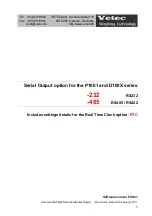
WELD SENTRY 2
Page 7
VOLTAGE CABLE INSTALLATION
1. Attach each of the voltage pickup leads to the electrodes.
Polarity is not critical, the Sentry uses the current signal to detect polarity.
Note: The leads should be as close as is practical to the tip end of each electrode.
The ideal objective would be is to measure
only
the weld voltage across the workpiece.
2. For production installations replace the clip leads with terminals and screw the leads to the electrode or
electrode holder to prevent movement.
3. Attach the cable in a fixed position along the weld head and back to the Weld Sentry.
Once attached, the position must be maintained to prevent variation in the voltage measurements,
4. Twist together any excess length of the two lead wires. This prevents pickup of voltage caused by
induction.
5. Figure 5 shows the typical attachments for measuring weld voltage.
Figure 5 - Connecting the Voltage Input cable to electrodes.
START SIGNAL INSTALLATION
The Start signal is designed as a means to detect "missing welds' or to prevent 'false triggering' in an
electrically noisy environment. Use of the Start Signal is optional and is not required for normal operation
of the Weld Sentry.
1.
Obtain the optional cable accessory, catalog number WSTC.
2.
Plug cable end with the jack plug to the two-pin Current Input connector on rear panel of the Sentry.
3.
Connect the end with the two wires to a signal source or device.
The signal can be originated by the actuation of the weld head or by the electrode force or a pressure
switch. It is not necessary for the start signal to be synchronized with the start of the weld pulse.
4.
The signal must occur just before the weld and remain ON for the duration of the weld.
Refer to Section 4 - Specifications.
Summary of Contents for WELD SENTRY 2
Page 5: ......













































